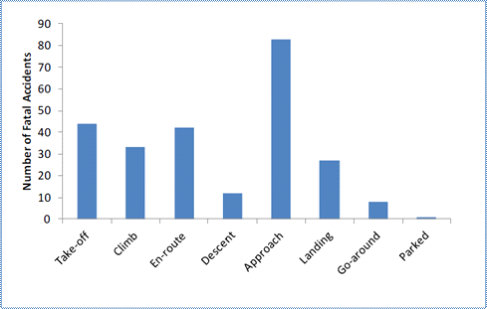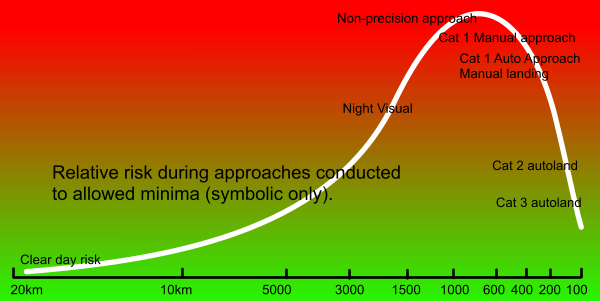The danger zone.
It is well-known that the majority of aircraft accidents still occur during the take-off, approach and landing phases of flight. This is hardly surprising since these are the times when the aircraft is closest to the ground and being subjected to large changes of speed and configuration. The chart below shows accidents to commercial jet airliners over 10 recent years. [Source: Boeing]

The second chart covers a wider range of operations including turbo-props and other commercial flying, from a UK CAA survey over much the same period, and published in 2013.

In this CAA analysis, 66% of all fatal accidents involved at least one airline related causal factor. “Flight handling” and “Omission of action or inappropriate action” were the joint most commonly assigned causal factors.
The latter generally related to flight crew continuing their descent below the decision height or minimum descent/safety heights without visual reference, failing to fly a missed approach or omitting to set the correct aircraft configuration for take-off. The most frequently allocated circumstantial factor was “Poor visibility or lack of external visual reference”. In the majority of cases when this circumstantial factor was assigned, the accident occurred during a period of thick fog.
It is very evident that even today
- most accidents still occur during the approach and landing
- a very high proportion occur close to or on the airport, i.e. between the outer marker and the end of the landing roll.
- 30% of approach-and-landing accidents occur during the conduct of visual approaches or during the visual segment of an instrument approach.
- Visual approaches at night present a greater exposure because of reduced visual cues, increased likelihood of visual illusions and risk of spatial disorientation.
- Low visibility and/or precipitation are circumstantial factors in more than 70 % of approach-and-landing accidents, including those involving CFIT.
Today's killer conditions.
For most landings made by commercial aircraft in VERY low visibility during the last two or three decades, advanced auto-flight systems including autoland have become standard equipment. Although there have been some alarming events occurring to even the most advanced aircraft, it is hard to find any accident that has occurred during an automatic landing. [Please inform this site's owner Steve Last if you have any information on such accidents.]
The major safety risk areas are still night visual, non-precision approaches, and ILS approaches without autoland. Represented symbolically in this curve, these operations, which are still by far the most common, involve risks which have changed very little since the introduction of turbine-powered aircraft over 50 years ago.
